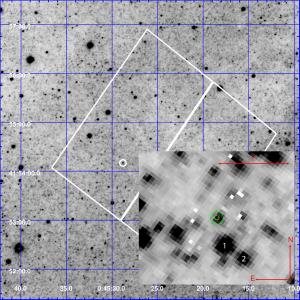Blog
Play It Again, Sam
11 April 2014
A recurrent nova is a stellar nova that occurs from the same star more than once. You’re probably more familiar with a supernova, where a star is ripped apart in a cataclysmic explosion. Novas occur when a white dwarf orbits with another star and captures some of the star’s outer material. This material forms an accretion disk around the white dwarf, which gradually falls to its surface. When material accumulates on the surface of the white dwarf, it can trigger a nuclear explosion that causes it to brighten similar to a supernova, but not nearly as intense. Since the explosion doesn’t destroy the star, it is possible for a nova to occur again after more material has accumulated.
The most famous recurrent nova is RS Ophiuchi, which becomes a nova about every 20 years. Other recurrent nova occur at different rates. Recurrent nova caused by more massive white dwarfs tend to have shorter repeat times than those with less mass. This seems to be due to the fact that stars with more gravity can accumulate matter from the companion star more quickly. Some recurrent nova have irregular repeat times, or have novae with highly varying brightnesses. This seems to be due to disruptions in the accretion disk when the star explodes.
It is thought that recurrent novas could be a precursor to the white dwarf becoming a supernova. If the material cast off by the nova is less than the material accumulated each time, then the white dwarf will gradually increase in mass. Eventually this bring its mass to the Chandrasekhar limit, which is the upper limit for the mass of a white dwarf. Beyond that point the star will collapse, which can trigger a supernova explosion.
 NASA/Hubble
NASA/HubbleRecently astronomers have discovered a fast recurrent nova in the Andromeda galaxy. A paper on the nova was recently published in Astronomy and Astrophysics, and presents some of the initial results.1 The star, known as M31N 2008-12a has a nova outburst about once a year. This is extremely rapid, since the next highest frequency rate is about once a decade. The star also brightens quickly and dims quickly, on the order of a few days. When observed in x-rays, it was found the star emits x-rays during the nova period for about 10 days. Since x-rays are generated by nuclear interactions, this indicates that the nuclear interactions on the surface only last about that long.
All of this points to M31N 2008-12a being a very massive white dwarf star. Since the novae occur so rapidly, it is clear that material from its companion star continues to accrete at a regular basis. It would seem that this star is on its way to becoming a supernova. Just how soon that might be is unknown, but it’s worth keeping an eye on. It could explode at any time.
Of course on a cosmic scale “any time” could be anywhere from tomorrow to thousands of years.
Henze, M., et al. “A remarkable recurrent nova in M 31: The X-ray observations.” Astronomy & Astrophysics 563 (2014): L8. ↩︎